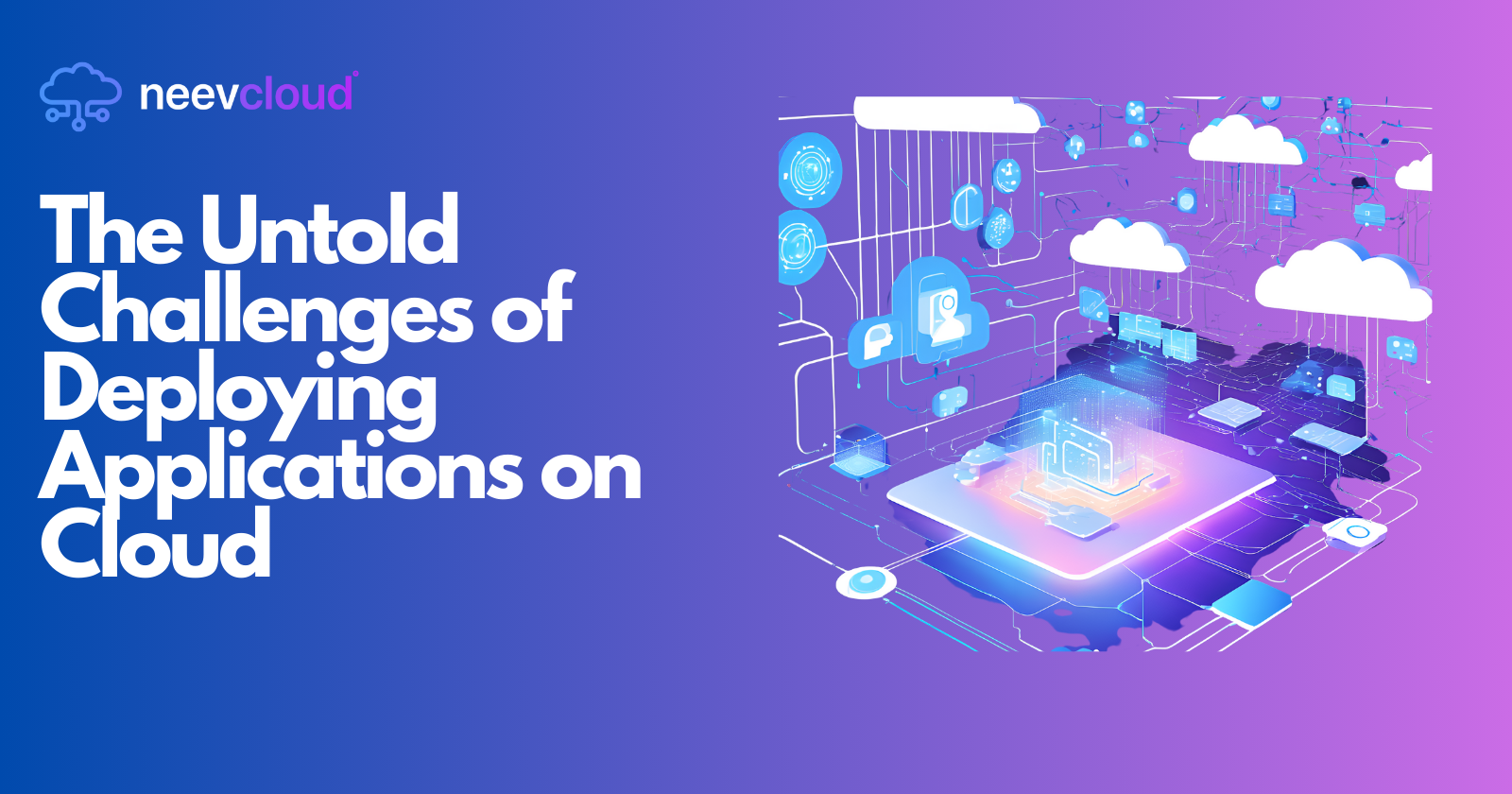The Untold Challenges of Deploying Applications on Cloud
 Tanvi Ausare
Tanvi Ausare
With the rapid rise in cloud technologies, organizations are deploying applications on the cloud at an unprecedented rate. However, moving to an AI cloud environment—particularly for machine learning (ML) and artificial intelligence (AI) workloads—is no simple feat. This article uncovers the lesser-known complexities, providing valuable insights for businesses and developers looking to leverage cloud capabilities effectively.
Introduction to Cloud Application Deployment
Deploying an application on the cloud often means leveraging a platform that can handle scaling, security, and resilience. But when we add AI, ML, or data-intensive processes into the mix, new factors come into play that can significantly impact the success of the deployment.
Key Challenges in Cloud Application Deployment for AI Workloads
Data Management & Privacy
Data is the backbone of AI and ML applications. But moving data to the cloud presents challenges in data management, privacy, and regulation compliance (e.g., GDPR, HIPAA).
Data locality is crucial in maintaining performance; for AI applications, data must often be as close to computation as possible to reduce latency.
Tip: Use data containers in AI DataCenters to organize and control data more effectively.
Scalability Concerns
While cloud platforms promise infinite scalability, scaling AI workloads is more complex. Training large models, such as LLMs (Large Language Models), requires massive computational resources that may lead to unpredictable costs.
Tip: Utilize specialized AI Datacenter solutions designed for scaling AI/ML applications without cost overruns.
Networking Latency & Bandwidth Issues
Cloud deployments for ML models require significant bandwidth and low-latency networking, especially for real-time applications.
Network bottlenecks can hinder performance, particularly when models are hosted in an AI Cloud.
Tip: Use content delivery networks (CDNs) or edge computing nodes to keep model inference close to users, reducing latency.
Behind the Scenes: Cost Management in AI Cloud Deployments
Managing costs in cloud deployments for AI and ML applications involves more than simple resource allocation:
Dynamic Cost Allocation
Many cloud providers offer dynamic pricing based on resource demand. However, AI workloads with large-scale data processing can lead to ballooning costs if not managed effectively.
Tip: Consider cost-effective machine learning inference offloading for tasks that can run on edge devices instead of centralized AI DataCenters.
Reserved Instances vs. On-Demand Pricing
Reserved instances can save costs but may lock you into a particular configuration, which might be a downside for highly dynamic AI workloads.
Tip: Evaluate your ML workload’s demand patterns to see if reserved instances or spot instances offer better value.
Ensuring AI and ML Model Consistency on the Cloud
Deploying models to production is only one part of the AI lifecycle. Ensuring consistency, accuracy, and up-to-date models on the cloud presents unique challenges:
Version Control for ML Models
Each model version needs to be tracked and managed carefully to ensure reproducibility and compatibility with other services.
Tip: Use tools like model registries and MLOps platforms to automate version control and model lifecycle management.
Model Drift and Performance Degradation
Model drift—where data patterns change over time—can lead to performance issues if not monitored. Cloud platforms often provide monitoring, but it may be limited for highly specialized AI tasks.
Tip: Set up custom model monitoring using cloud services like Azure ML Monitor or AWS SageMaker Model Monitor to catch drift early and adjust models.
Security: A Hidden Challenge in AI Cloud Deployment
AI models and datasets are prime targets for cyber threats. Ensuring their security while maintaining accessibility in the cloud involves a strategic approach.
Data Encryption and Model Security
Protecting data in transit and at rest is a must. However, AI models themselves also need to be protected, as they can reveal sensitive insights.
Tip: Use end-to-end encryption and consider homomorphic encryption for sensitive model data.
Role-Based Access Control (RBAC) and Identity Management
AI cloud platforms often provide basic security controls, but RBAC and identity management must be carefully configured for optimal security.
Tip: Apply Zero Trust principles to limit access to AI resources, ensuring that only necessary roles have permissions.
Performance Optimization Tactics for AI and ML Workloads
When deploying ML applications on the cloud, performance optimization is vital to prevent user dissatisfaction and high operational costs.
Efficient Utilization of Cloud GPU Resources
ML models are resource-intensive, especially on GPUs, and cloud costs can escalate quickly.
Tip: Use GPU autoscaling and look for cloud-native GPU management tools, such as NVIDIA’s DCGM Exporter, to monitor and optimize GPU usage dynamically.
Inference Optimization for Real-Time AI Applications
For applications requiring real-time processing, cloud inference optimization is crucial. Latency issues can greatly affect the end-user experience.
Tip: Optimize for real-time with batching and model quantization techniques to enhance inference speed.
Containerization: A Key Player in AI Cloud Deployment
Containerization is often considered the gold standard for cloud deployment due to its flexibility and scalability. However, AI applications bring unique needs.
Dockerizing ML Models
ML models need careful Dockerization to ensure consistency, manage dependencies, and optimize deployment pipelines.
Tip: Use tools like NVIDIA’s DeepStream for high-performance streaming and inference if deploying to NVIDIA GPU Cloud (NGC).
Container Orchestration with Kubernetes
While Kubernetes is the go-to for container orchestration, integrating AI/ML workloads requires specialized handling, such as GPU resource management.
Tip: Implement GPU-enabled Kubernetes clusters to maximize efficiency and performance for ML workloads.
Monitoring and Maintenance of AI/ML Deployments in the Cloud
Once deployed, ML applications on the cloud require regular monitoring and maintenance to ensure that they continue to operate optimally and meet business objectives.
Observability in AI Workloads
Observability is crucial for understanding how models perform in production. However, traditional APM (Application Performance Monitoring) solutions often fall short for AI applications.
Tip: Use ML-focused observability platforms such as WhyLabs or Arize AI to monitor models effectively.
Automatic Model Retraining
In rapidly changing data environments, models must often be retrained. This retraining needs to be automated for models to stay accurate.
Tip: Set up CI/CD pipelines specific to ML models to automate retraining and redeployment processes.
Compliance and Regulatory Hurdles in AI Cloud Deployments
In certain industries, compliance requirements add an extra layer of complexity to AI cloud deployments.
Data Sovereignty
Many organizations face restrictions on where their data can be stored or processed. This is especially true in healthcare, finance, and government sectors.
Tip: Choose a multi-region AI Datacenter that meets data residency requirements.
Compliance Automation
Cloud providers offer some tools for regulatory compliance, but these are typically generic and may not cover AI-specific needs.
Tip: Implement compliance automation solutions to monitor and enforce industry-specific regulations across AI workloads.
Future Trends and Conclusion
Looking ahead, AI cloud deployment is poised to evolve with advances in edge computing, federated learning, and better interoperability among cloud providers. The rise of dedicated AI data centers, along with AI-optimized hardware like NVIDIA H100, will play a significant role in optimizing and scaling AI cloud applications efficiently.
Summary: Key Takeaways
Data locality and privacy are critical—ensure your data architecture aligns with regulatory and performance needs.
Cost management is essential in AI workloads; explore reserved or spot instances to optimize expenses.
Security concerns extend beyond data—protect your AI models from malicious attacks and intellectual property theft.
Optimize performance using specialized tools like NVIDIA DCGM for GPUs and edge computing for low-latency requirements.
Monitor and maintain your ML models with AI-specific observability platforms for best results.
Stay compliant with regulations by choosing multi-region data centers and implementing compliance automation.
By understanding these challenges and implementing strategic solutions, your team can fully leverage the power of AI cloud deployments while avoiding common pitfalls.
Subscribe to my newsletter
Read articles from Tanvi Ausare directly inside your inbox. Subscribe to the newsletter, and don't miss out.
Written by
